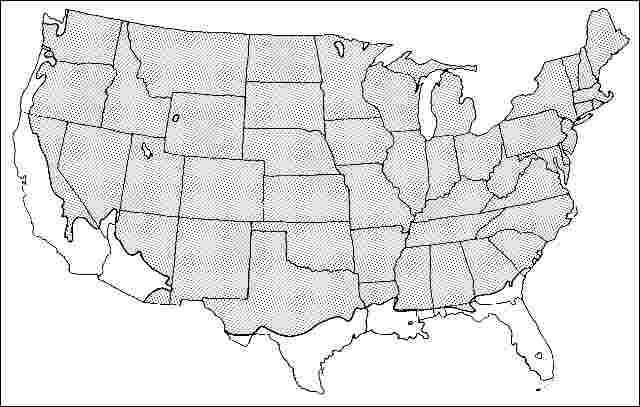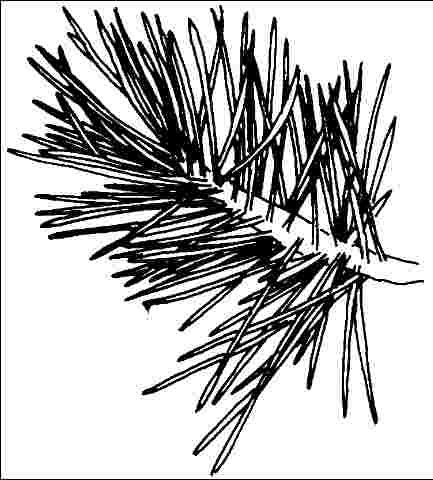Introduction
In recent years the tree has been bothered with fatal attacks of pine wilt nematode, therefore, its use in landscapes is not recommended in many areas. A widely planted evergreen in the past that will grow 40 to 50 feet tall and 30 feet wide, scotch pine has bluish-green to green foliage which usually turns yellowish green in winter. Orange bark on the trunk and major limbs peels in papery flakes, and is visible through the canopy. The plant will tolerate dry soil and exposed sites forming an open, picturesque, asymmetrical canopy.

Credit: Ed Gilman, UF/IFAS
General Information
Scientific name: Pinus sylvestris
Pronunciation: PIE-nus sill-VESS-triss
Common name(s): Scotch Pine
Family: Pinaceae
USDA hardiness zones: 3A through 8A (Fig. 2)
Origin: not native to North America
Invasive potential: invasive non-native
Uses: reclamation; Bonsai; Christmas tree
Availability: not native to North America

Description
Height: 40 to 50 feet
Spread: 25 to 30 feet
Crown uniformity: irregular
Crown shape: oval
Crown density: open
Growth rate: moderate
Texture: fine
Foliage
Leaf arrangement: alternate (Fig. 3)
Leaf type: simple
Leaf margin: entire
Leaf shape: needle-like (filiform)
Leaf venation: parallel
Leaf type and persistence: fragrant, evergreen, needled evergreen
Leaf blade length: less than 2 inches, 2 to 4 inches
Leaf color: green
Fall color: no color change
Fall characteristic: not showy

Flower
Flower color: yellow
Flower characteristics: not showy
Fruit
Fruit shape: oval, cone
Fruit length: 1 to 3 inches
Fruit covering: dry or hard
Fruit color: brown
Fruit characteristics: does not attract wildlife; not showy; fruit/leaves a litter problem
Trunk and Branches
Trunk/bark/branches: branches don't droop; showy; typically one trunk; thorns
Pruning requirement: little required
Breakage: susceptible to breakage
Current year twig color: green
Current year twig thickness: medium
Wood specific gravity: unknown
Culture
Light requirement: full sun
Soil tolerances: clay; sand; loam; acidic; slightly alkaline; well-drained
Drought tolerance: high
Aerosol salt tolerance: moderate
Other
Roots: not a problem
Winter interest: yes
Outstanding tree: no
Ozone sensitivity: sensitive
Verticillium wilt susceptibility: resistant
Pest resistance: sensitive to pests/diseases
Use and Management
It is a good tree for reclamation sites, is tough and durable, and is very popular as a Christmas tree. It is often sprayed with green dye to give it a desirable green color for the holiday season. It is somewhat tolerant of basic soil pH, below 7.5.
Propagation is from seed which germinate readily.
Pests
Pine wilt nematode may be the most significant pest at this time.
Bark beetles bore into trunks making small holes scattered up and down the trunk. The holes look like shotholes. Stressed trees are more susceptible to attack. Keep trees healthy.
Sawfly larvae caterpillars are variously colored but generally feed in groups on the needles. Some sawfly larvae will flex or rear back in unison when disturbed. Sawflies can cause rapid defoliation of branches if left unchecked.
Pine needle scale is a white, elongated scale found on the needles. Pine tortoise scale is brown and found on twigs. Depending on the scale, horticultural oil may control overwintering stages.
Zimmerman pine moth larvae bore into the trunk. The only outward symptoms may be death of parts of the tree or masses of hardened pitch on the branches.
The larvae of pine weevils feed on the sapwood of the leaders. The leader is killed and the shoots replacing it are distorted. First symptoms are pearl white drops of resin on the leaders. The leaders die when the shoot is girdled as adults emerge in August. Prune out and burn infested terminals before July 15.
Pine shoot beetle is the latest recognized problem beginning to plague this tree.
Diseases
Canker diseases may rarely cause dieback of landscape pines. Keep trees healthy and prune out the infected branches.
Needle cast is common on small trees and plantation or forest trees. Infected needles yellow and fall off.
Scots Pine is very susceptible to pine wilt nematode.